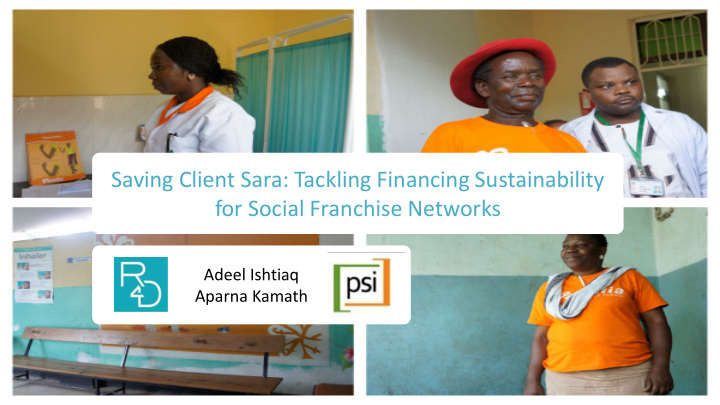



Saving Client Sara: Tackling Financing Sustainability for Social Franchise Networks Adeel Ishtiaq Aparna Kamath
Global Setting Concerns about decline in donor funding globally and nationally is Declining Donor moving SF networks to adopt more financially sustainable models Support Private sector critical for FP as a vehicle for increasing subsidized Expanding Choice of access and assuring a range of commodities and services across FP Methods all income groups and all social groups As countries mobilize resources towards UHC agenda, need to Addressing address fragmentation to reduce inefficiencies and expand Fragmentation population coverage
The SIFPO2 Project The SIFPO2-supported partnership between PSI and R4D aims to increase the capacity of PSI and affiliated social franchising networks to leverage domestic financing, enhance FP service delivery, and reduce fragmentation in the health market in the context of UHC. Goals: Define role for PSI at the interface of public financing and private delivery • Develop strategies for financial sustainability that support goals of quality, • access, equity, additionality, and cost-effectiveness
Framework
Developing Options for the Financial Sustainability of the Confidence Franchise in Birani CASE STUDY
The Confidence Franchise Scope of the franchise: National, and moderately sized. Equal urban vs. rural distribution • SRH offerings are core services, but the program has added IMCI, • malaria, CCSPT, and HIV services Strengths of the franchise: High-quality services, skills in behavior change communication • Clients are largely Q1, Q2, and Q3 • 40% of franchisees enrolled with NHIS, but mostly large clinics and • hospitals in urban areas Challenges of the franchise: Projects are heavily donor reliant, with relatively non-fungible funding • Franchisees largely receive out-of-pocket payments from clients • Franchisees have difficulty meeting NHIS accreditation standards and • receiving payments
Health Financing Mechanisms National Health Insurance Scheme Challenges Opportunities Covers largely formal sector, with voluntary schemes Looking to expand to rural areas • • for informal sector Often works with intermediaries for claims • Capitation payment standard across public and processing and payment • private sector; public sector receives input subsidies Global Financing Facility for RMNCAH Challenges Opportunities No private sector representation in developing Expected to roll-out through NHIS in poor • • investment case and underserved areas Public sector has mixed record on managing RBF payment rewards high quality and • • RBF; added reporting burden on facilities access for Q1/Q2 clients
Health Market Landscape Supportive Functions Private Sector underutilized but PPP Policy under development addresses both supply and and set to include private sector demand side factors Rules Shift to RBF for all health purchasing Local Govt. Authorities drawing Up Comprehensive Health Plans with private sector Stakeholders & Collaborators Confidence Franchise Association of Private Health Facilities (APHF) organizing private sector at National level WeCare international carrying out bulk purchasing for private facilities
Options Analysis What? Brief description of the idea • Why? Challenges/opportunities the idea is targeting • How? Mechanism for implementing this idea • SWOT Analysis Main strength, weakness, opportunity, and challenge for • implementation One point per quadrant • Stakeholder Analysis Main benefit for client, franchisee, franchisor, and other • partners One point per quadrant •
THANK YOU! Aparna Kamath Adeel Ishtiaq akamath@r4d.org aishtiaq@r4d.org
Recommend
More recommend